
Guide dogs are assistance dogs trained to lead blind or visually impaired people around obstacles. Although dogs can be trained to navigate various obstacles, they are red–green colour blind and incapable of interpreting street signs. The human does the directing, based on skills acquired through previous mobility training. The handler might be likened to an aircraft's navigator, who must know how to get from one place to another, and the dog is the pilot, who gets them there safely. In several countries guide dogs, along with most other service and hearing dogs, are exempt from regulations against the presence of animals in places such as restaurants and public transportation.

The German Shepherd, also known in Britain as an Alsatian, is a German breed of working dog of medium to large size. The breed was developed by Max von Stephanitz using various traditional German herding dogs from 1899.
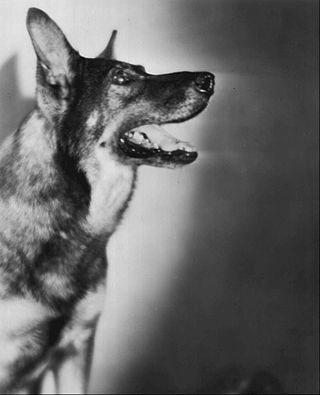
Rin Tin Tin or Rin-Tin-Tin was a male German Shepherd born in Flirey, France, who became an international star in motion pictures. He was rescued from a World War I battlefield by an American soldier, Lee Duncan, who nicknamed him "Rinty". Duncan trained Rin Tin Tin and obtained silent film work for the dog. Rin Tin Tin was an immediate box-office success and went on to appear in 27 Hollywood films, gaining worldwide fame. Along with the earlier canine film star Strongheart, Rin Tin Tin was responsible for greatly increasing the popularity of German Shepherd dogs as family pets. The immense profitability of his films contributed to the success of Warner Bros. studios and helped advance the career of Darryl F. Zanuck from screenwriter to producer and studio executive.

A working dog is a dog used to perform practical tasks, as opposed to pet or companion dogs.

Dog training is a kind of animal training, the application of behavior analysis which uses the environmental events of antecedents and consequences to modify the dog behavior, either for it to assist in specific activities or undertake particular tasks, or for it to participate effectively in contemporary domestic life. While training dogs for specific roles dates back to Roman times at least, the training of dogs to be compatible household pets developed with suburbanization in the 1950s.

Where the Red Fern Grows is a 1961 children's novel by Wilson Rawls about a boy who buys and trains two Redbone Coonhounds for hunting. It's a work of autobiographical fiction based on Rawls' childhood in the Ozarks.

The Canaan Dog is a dog breed developed in the early 20th century from semiwild pariah dogs that were the descendants of animals present in the region since biblical times. It is a breed of pariah dog found across the Middle East. It can be found in Jordan, Israel, Lebanon, Palestine, and the Sinai Peninsula and these, or dogs nearly identical, were also found in Syria over 9,000 years ago. It is the national dog of Israel. As of 2012, there were 2,000 to 3,000 Canaan Dogs across the world.
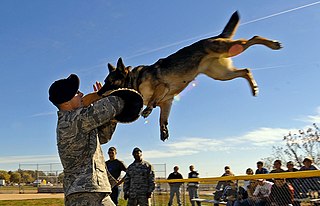
An attack dog is a dog trained to attack a person on command, sight, or by inferred provocation. They are used to defend people, territory, or property. Attack dogs have been utilized throughout history and are used today primarily in police and military roles. They have also been involved in a number of dog-related incidents and fatalities.

Dogs have a very long history in warfare, starting in ancient times. From being trained in combat, to their use as the scouts, sentries, messengers, mercy dogs, and trackers, their uses have been varied and some continue to exist in modern military usage.

The Guide Dogs for the Blind Association, known colloquially as Guide Dogs, is a British charitable organisation that uses guide dogs to help blind and partially blind people. The organisation also participates in political activism for the rights of those with vision impairments.
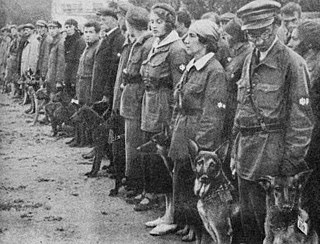
Anti-tank dogs were dogs taught to carry explosives to tanks, armored vehicles, and other military targets. They were intensively trained by the Soviet and Russian military forces between 1930 and 1946, and used from 1941 to 1943, against German tanks in World War II. Initially, dogs were trained to leave a timer-detonated bomb and retreat.

Dog daycare, or doggy daycare, is short-term daytime care for dogs. It differs from multi-day kennel boarding and pet sitting, where the sitter comes to the pet's home.

The Intelligence of Dogs: A Guide to the Thoughts, Emotions, and Inner Lives of Our Canine Companions is a 1994 book on dog intelligence by Stanley Coren, a professor of canine psychology at the University of British Columbia. The book explains Coren's theories about the differences in intelligence between various breeds of dogs. Coren published a second edition in 2006.

Where the Red Fern Grows is a 2003 American drama adventure film directed by Lyman Dayton and Sam Pillsbury and starring Joseph Ashton, Dave Matthews, Ned Beatty and Dabney Coleman. Based on the children's book of the same name by Wilson Rawls and a remake of the 1974 film of the same name, it follows the story of Billy Colman who buys and trains two Redbone Coonhound hunting dogs to hunt raccoons in the Ozark mountains.
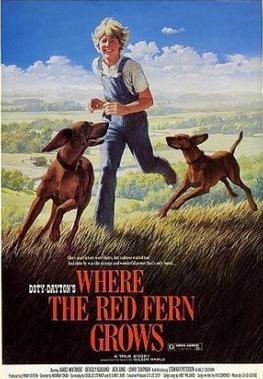
Where the Red Fern Grows is a 1974 drama film directed by Norman Tokar and starring James Whitmore, Beverly Garland, Stewart Petersen and Jack Ging. It is based on the 1961 novel of the same name.

The Winery Dogs are an American hard rock supergroup formed in 2012 by Mike Portnoy, Billy Sheehan and Richie Kotzen.
The Biscuit Eater is a 1940 children's film directed by Stuart Heisler and starring Billy Lee and Cordell Hickman as two kids who raise a runt of a dog. It was named one of the Top Ten Films of 1940 by the National Board of Review. Walt Disney Productions made a 1972 remake under the same title.
Dogs played various roles during the time of the American Revolutionary War. In addition to formal uses like their role in hunting, dogs often accompanied their owners while they were fighting and provided comfort for their owners and those with them in camps. During this time, dogs were being newly studied in science and depicted in art.
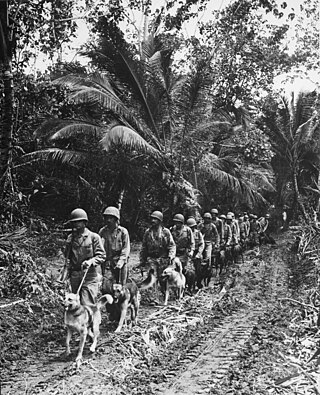
The San Carlos War Dog Training Center also called the Western Remount Area Reception and Training Center was located at San Carlos, California. Then was built at the old H & H Ranch. The US Army opened the 177 acre center on October 15, 1942. The center was used to train US Army dogs. The US Army ended the land lease on November 1, 1944. The land was built in to family homes in the 1950s. San Carlos War Dog Training Center was one of five US Army dog training centers. The center was operated by the US Army Quartermaster Corps. Trained dogs were an important part of the World War II efforts. German Shepherds, Belgian Sheep dogs, Doberman Pinschers, farm Collies and Giant Schnauzers were trained at the center. At the center dogs were trained to be guards, scouts, messengers, mine detectors, sled and pack dogs. The training took 8 to 11 weeks, the dogs and the trainers were housed at the center. Training was at first basic dog training, then advanced to dog being at easy with gunfire, riding in military vehicles and wearing gas masks. At is peak there were 550 troops, 15 civilian contractors and up to 1,200 dogs at the center. By the end of the war 4,500 dogs and 2,500 men were trained at the center.

A mercy dog was a dog that served in a paramedical role in the military, most notably during World War I. They were often sent out after large battles, where they would seek out wounded soldiers, and they were well-suited to the conditions of trench warfare. They carried first-aid supplies that could then be used by wounded soldiers, and comforted dying soldiers who were mortally wounded. They were also trained to guide combat medics to soldiers who required extensive care. Many mercy dogs were trained by national Red Cross societies to serve the country in which the specific society operated. The German army called such dogs medical dogs. As many as 20,000 dogs are estimated to have served as mercy dogs in World War I and World War II, and they have been credited with saving thousands of lives. Such dogs were also used by the United States in the Korean War.

















